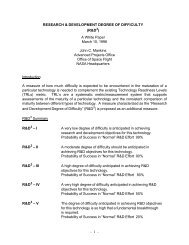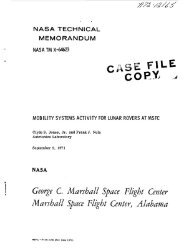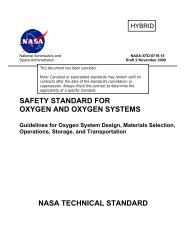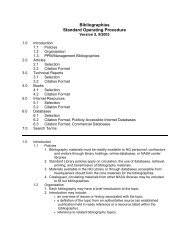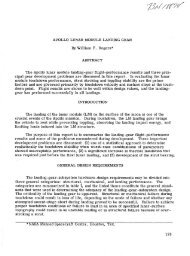crimping, interconnecting cables, harnesses, and wiring - NASA
crimping, interconnecting cables, harnesses, and wiring - NASA
crimping, interconnecting cables, harnesses, and wiring - NASA
You also want an ePaper? Increase the reach of your titles
YUMPU automatically turns print PDFs into web optimized ePapers that Google loves.
19. SPLICING<br />
19.1 General<br />
Page 80 of 114<br />
<strong>NASA</strong>-STD-8739.4 with Change 6<br />
Splices may be configured as a simple splice, having one conductor joined to another conductor,<br />
or as a complex splice with one or more conductors joined to one or more other conductors.<br />
Splices may be completed using <strong>crimping</strong> or soldering processes.<br />
19.2 General Information<br />
Unless identified as part of the design in the manufacturing/engineering documentation, splices<br />
shall be considered repairs <strong>and</strong> shall be h<strong>and</strong>led in accordance with paragraph 4.5.2<br />
(Requirement).<br />
19.2.1 Soldered splice terminations shall comply with <strong>NASA</strong>-STD-8739.3. Solder connections<br />
shall be inspected prior to <strong>and</strong> after shrink tube heat application (Requirement).<br />
19.2.2 All areas that will be under insulation sleeving shall be cleaned with an approved solvent<br />
as defined by <strong>NASA</strong>-STD-8739.3 Table 6.1 (Requirement). Cleaning solution application shall<br />
be controlled to minimize propagation to other areas of the harness or cable being spliced<br />
(Requirement).<br />
19.3 Design Considerations<br />
The use of splices in a harness design should be minimized as much as possible. The simplest<br />
<strong>and</strong> most reliable <strong>wiring</strong> design is one that results in the routing of a dedicated, continuous, <strong>and</strong><br />
unbroken conductor from point to point. The following shall be incorporated into any splice<br />
design:<br />
19.3.1 Shrink sleeving over the splice area shall be protected from cold flow <strong>and</strong> abrasion<br />
(Requirement).<br />
19.3.2 Splices shall be covered with a single layer of heat-shrinkable tubing or insulation<br />
material that meets or exceeds the minimum electrical isolation specified in the engineering<br />
documentation (Requirement). The tubing/insulation shall completely encapsulate the splice<br />
body <strong>and</strong> extend over the wires’ insulation a minimum of two times (2X) the diameter of the<br />
largest wire in the splice (Requirement). Additional layers of tubing/insulation may be added to<br />
increase electrical isolation or to provide additional environmental or mechanical protection.<br />
Each additional layer shall overlap the underlying layer by at least two (2) diameters of the<br />
largest wire in the splice at each end (Requirement).<br />
19.3.3 Splices shall be staggered to minimize buildup of the wire bundle diameter<br />
(Requirement).<br />
19.3.4 Splices shall not be located in areas of the cable where flexing may occur or in bend radii<br />
where the primary insulation may be compromised (Requirement).<br />
19.3.5 There shall be no splices within two harness diameters of a breakout (Requirement).<br />
19.3.6 Splices, including location <strong>and</strong> type, shall be identified <strong>and</strong> fully defined on the<br />
associated drawings (Requirement).






